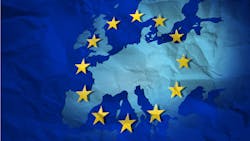The European Commission Announces Sweeping Climate Legislation
Download this article in PDF format.
Intent on making Europe the first climate-neutral continent by 2050, the European Commission (the EU’s executive branch) recently introduced sweeping new legislation and its intent to reduce the EU’s net carbon emissions by at least 55% by 2030. Released in mid-July, the “Fit for 55” package proposes revisions to several pieces of EU climate legislation, including the EU ETS, Effort Sharing Regulation, and transport and land use legislation. It also sets forth the terms for reaching EU climate targets under the European Green Deal.
According to the AP, the Fit for 55 package includes about 12 major proposals ranging from the de-facto phasing out of gasoline and diesel cars by 2035 to new levies on gases from heating buildings. AP also says most of the proposals build on existing laws that were designed to meet the EU’s original goal of cutting 40% GHG emissions by 2030 (compared to 1990’s levels).
Part of a Larger Mission
Each of the proposals is part of the EU’s larger mission of ensuring a fair, competitive and green transition by 2030. The package strengthens eight existing pieces of legislation, according to the European Commission, and presents five new initiatives across a range of policy areas and economic sectors: climate, energy and fuels, transport, buildings, and land use and forestry.
“We are at a pivotal moment in the world’s response to the climate and biodiversity emergencies and we are the last generation that can still act in time,” The European Commission states. “This decade is a make-or-break moment for delivering on our commitments under the Paris Agreement,” it continues, “in the interest of the health, wellbeing and prosperity of all.”
The Paris Agreement is a legally-binding international treaty on climate change. It was adopted by 196 Parties at COP 21 in Paris in December 2015 and entered into force in November 2016.
The agreement’s goal is to limit global warming to well below 2°C—and preferably to 1.5°C—compared to pre-industrial levels. To achieve this long-term temperature goal, countries aim to reach global peaking of greenhouse gas emissions as soon as possible to achieve a climate neutral world by mid-century.
Forging a Greener Path
With the EU currently accounting for 8% of global CO2 emissions, the Commission says it recognizes the responsibility for a higher share of cumulative emissions. As such, it wants to “decisively forge a path towards a green, competitive, inclusive, circular economy.” The European Green Deal, the continent’s growth and competitiveness strategy, is also helping to transform the global narrative, affecting political and business markets, and offering an example to follow.
The European Green Deal is a package of measures ranging from cutting greenhouse gas emissions, to investing in cutting-edge research and innovation, to preserving Europe’s natural environment. The initial climate action initiatives under the Green Deal include the European Climate Law to enshrine the 2050 climate-neutrality objective into EU law; the European Climate Pact to engage citizens and all parts of society in climate action; and the 2030 Climate Target Plan to further reduce net greenhouse gas emissions by at least 55% by 2030 (among others).
Calling the Fit for 55 package a “key milestone on the road to Glasgow” (where the next UN Climate Change Conference will be held later this year), the Commission expects the new legislation to serve as the “backbone of the EU’s delivery on its commitments to the planet and the world, as signed in the Paris Agreement.”
Carbon Border Adjustment Mechanism
As part of the new legislation, the Commission is also proposing a Carbon Border Adjustment Mechanism (CBAM), which will introduce a market dynamic that protects the integrity of the EU and global climate policy by reducing GHG emissions in the EU and globally. The CBAM will also induce relevant sectors to modernize, the Commission says, becoming more sustainable and driving down their carbon content.
The CBAM’s goal is to address “carbon leakage” in a way that helps the EU achieve its climate objectives. It works like this: Goods imported into the EU should be covered by equivalent carbon pricing to that applicable to production of the same goods within the EU, under the Emissions Trading System.
The Commission says that the CBAM will be gradually introduced for a few selected products. A simplified system will apply in the first years, with the objective of facilitating a smooth rollout of the mechanism. The proposal for a CBAM ensures that the same carbon price will be paid by domestic and imported products, and will thus be non-discriminatory and compatible with WTO rules and other international obligations of the EU.
The new legislation now has to be endorsed by the EU’s 27 member countries and lawmakers.
“The announcement starts what is expected to be a two-year process during which the details and ambitions of the proposals will be fought over by the EU’s national governments and the European Parliament,” Deutsche Welle reports. “Governments from outside of the EU and lobbies for affected industries will also do everything they can to amend the plans to fit their desires.”
About the Author

Bridget McCrea
Contributing Writer | Supply Chain Connect
Bridget McCrea is a freelance writer who covers business and technology for various publications.







